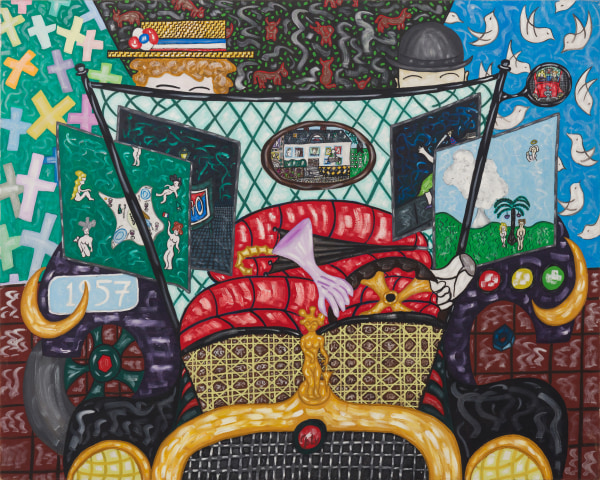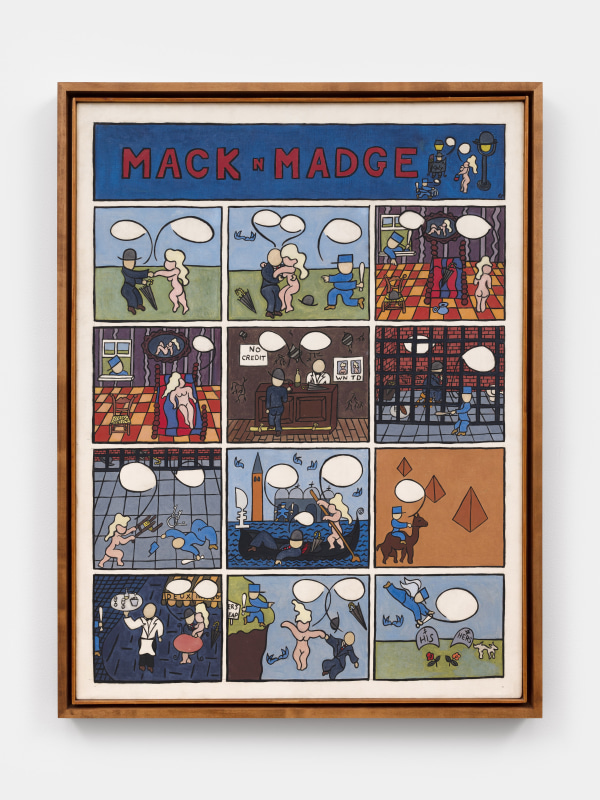Booth H11
For Art Basel 2022, Kasmin presented William N. Copley: The Paris Years in the fair’s Feature section. Bringing together a selection of significant paintings, alongside rare sculptural objects and the artist's first three-panel folding screen, this focused historical exhibition highlights the development of Copley’s art during his expatriation to postwar France, where the artist lived from 1951 to 1962. The work realized during this pivotal period saw Copley generate themes and subjects that became signature elements in his lexicon of images, comprising a self-taught style distinctive for its humorous spirit of political, social, and sexual provocation.
-
-
For Art Basel 2022, Kasmin presented William N. Copley: The Paris Years in the fair’s Feature section (Booth H11). Bringing together a selection of significant paintings, alongside rare sculptural objects and the artist's first three-panel folding screen, this focused historical exhibition highlighted the development of Copley’s art during his expatriation to postwar France, where the artist lived from 1951 to 1962. The work realized during this pivotal period saw Copley generate themes and subjects that became signature elements in his lexicon of images, comprising a self-taught style distinctive for its humorous spirit of political, social, and sexual provocation.
-
Moving to Paris in 1951 from Los Angeles, Copley’s work during this decade processes a new world and visibly delights in Europe’s idiosyncratic cultural and artistic history. Encountering an established artistic tradition (the “École de Paris”) which the artist rejected, he pursued instead an irreverent painterly style. “The French take art very seriously, and I just couldn’t help wanting to bait them a little. They really were so damn shockable”, reflected the artist. On this period of Copley’s artmaking, ICA Miami curator Stephanie Seidel observes, “Going against the grain geographically as well as stylistically—his Surrealism-inflected figurative painterly mode could not have been more different from the gestural abstraction ascendant in America—Copley created a critical distance for himself from both the American and French art worlds while nurturing his fascination with both countries’ national idiosyncrasies.”
In 1954, Copley purchased a home outside of the city in the northern commune Longpont-sur-Orge, which became a gathering place for him and his fellow avant garde artists. Here, he and his second wife, Noma, frequently hosted friends and peers such as Marcel Duchamp, Max Ernst, René Magritte, and Man Ray. The importance of Longpont as an incubator for creativity is reflected in Copley’s return to the subject of the home in various paintings, as seen in the center detail of Fête Foraine (1957). This work pays homage to diverse historical references, present too in Copley’s depiction of bidets, featured in as Bidealisme (1951), that recall Duchamp’s radical readymade Fountain, or his female nudes which playfully nod to the European artistic tradition of the previous century. Works such as Mack n Madge (1962) feature the anonymous, besuited man in a bowler hat that recurs in homage to the artist’s friend René Magritte as well as acting a symbol of a bourgeois, ultra-conservative upbringing that Copley had since renounced.
Copley’s interiors and cityscapes make direct references to the French capital, as exemplified by the stained glass rose windows and gothic parapets of Notre Dame in Auto École (1955). The artist’s series of Car paintings from 1955 and 1956 depict automobiles romping through European city streets and countryside picnics, evoking Manet’s Dejeuner Sur L’Herbe. Bombastically colliding shards of contrasting imagery, works such as Fête de Dimanche (1957) provide a fitting metaphor for Copley’s dynamic style that collides a multiplicity of jovial narratives.
Copley’s skepticism toward nationalism arose in part from the artist’s experiences in the US military. The flag motif is explored by the artist throughout his oeuvre, delivering a satirical critique of the blind patriotism such symbols codify. Drapeau Français (Vinland) (1961), depicts wine bottles in three partitions colored in the red, white and blue of the French flag, while Cplyland (Boy Meets Girl) (1962) pulls from the American stars and stripes and was first exhibited at Galerie Iris Clert, Paris, in 1962.
William N. Copley (1919-1996), also known as CPLY (pronounced see-ply) was a painter whose activities also included writing, publishing, collecting and patronage. From 1947-8 he ran the Copley Galleries in Beverly Hills, exhibiting works by prominent European and American Surrealist artists. Encouraged by Man Ray, Max Ernst and Marcel Duchamp, his first solo exhibition as a painter took place at Royer’s Bookshop, Los Angeles, in 1951. In the years that followed he had numerous solo exhibitions in the USA and Europe, and in 1981 a travelling retrospective toured to Kunsthalle Bern, Switzerland; Centre Georges Pompidou, Paris; Stedelijk Van Abbemuseum, Eindhoven, Netherlands and Badischer Kunstverein, Karlsruhe, Germany. In addition, he participated in seminal group exhibitions including documenta 5 (1972) and documenta 7 (1982).
Copley’s work has been exhibited internationally and is now held in public and private collections worldwide. Most recently major solo exhibitions have included The Coffin They Carry You Off In, ICA Institute of Contemporary Art Miami, Miami (2018); Fondazione Prada, Milan (2016); The World According to CPLY, The Menil Collection, Houston (2016) and Frieda Burder Museum, Baden Baden (2012); and William N. Copley & Andreas Slominski – X-RATED, a dual exhibition presented at the me Collectors Room, Berlin (2011).
Read more about William N. Copley here.
All artworks © 2022 William N. Copley Estate / Artists Rights Society (ARS), New York. Courtesy of Kasmin. -














